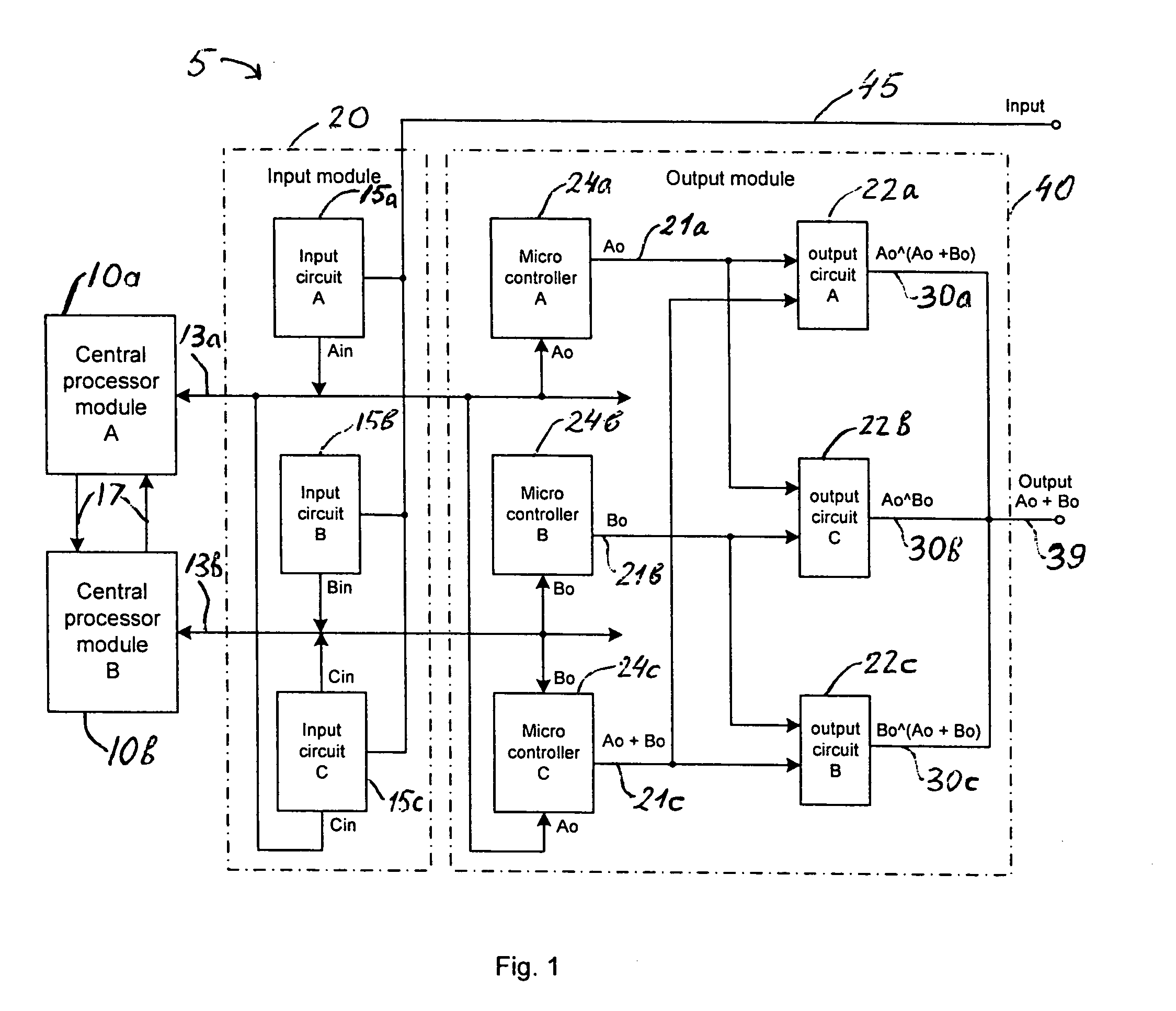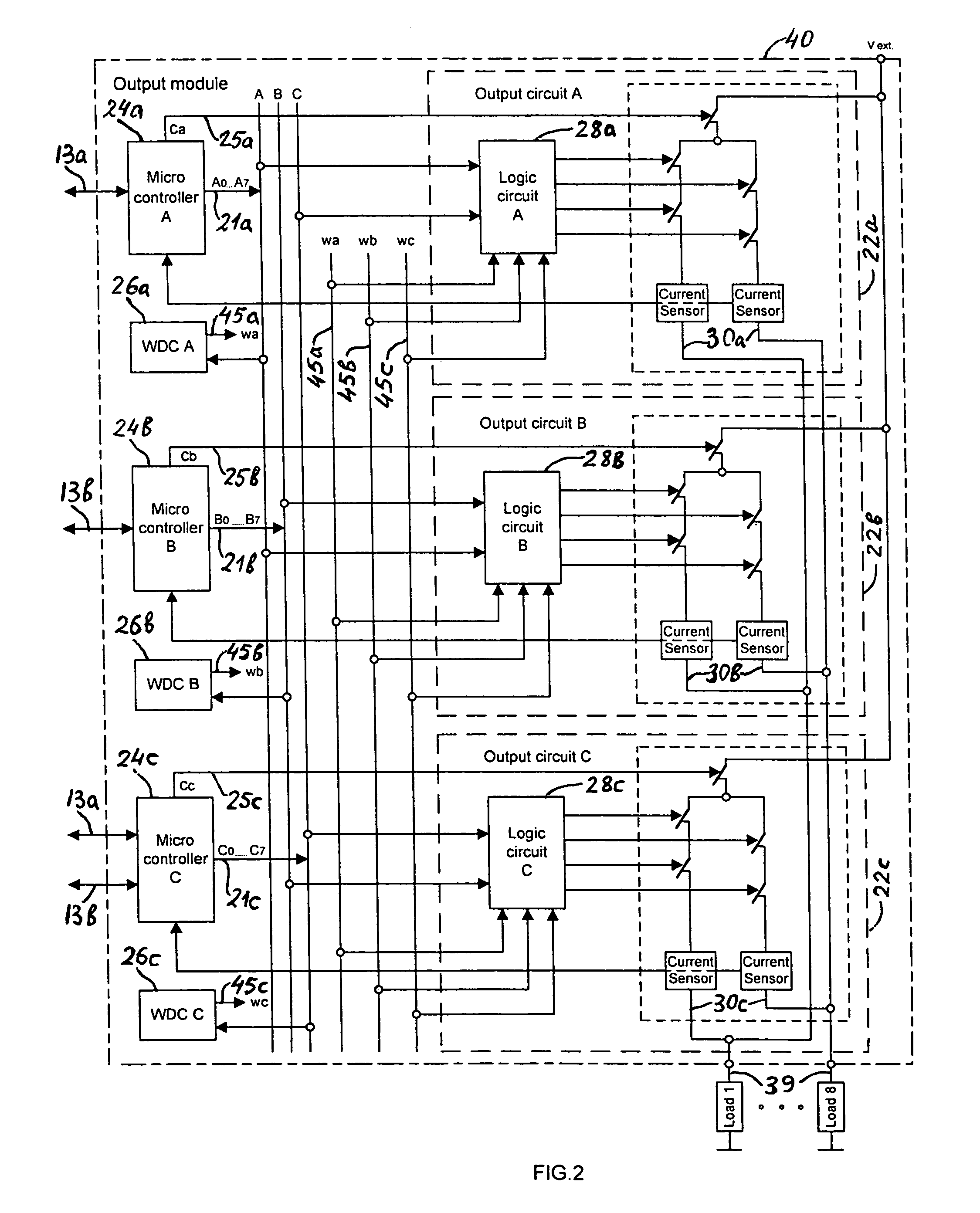Dual/triple redundant computer system
a computer system and triple redundant technology, applied in the field of computer systems, can solve the problems of safe or dangerous, human beings' safety, safe failure, etc., and achieve the effect of less expansive and sacrifice of system reliability
- Summary
- Abstract
- Description
- Claims
- Application Information
AI Technical Summary
Benefits of technology
Problems solved by technology
Method used
Image
Examples
second embodiment
3. the System
[0096]The system 5 alternate embodiment (FIG. 3) comprises an input module 20a, an output module 40a, a first and a second central processor module 50a, 50b. The central processor modules 50 operate in parallel. The alternate embodiment also includes an input / output processor (IOP) 52. The central processor modules (CPM) 50a, 50b communicate each to other and to the IOP 52 over three communication links 17a, 17b, and 17c. The first and the second central processor module 50a and 50b also communicate with input module 20a and output module 40a via I / O buses 13a and 13b respectively. The IOP 52 communicates with input module 20a and output module 40a via I / O bus 13c.
[0097]Referring to FIGS. 2 and 3, input modules 20 and 20a in the first and the second system embodiment are similar. A single difference between them is the input circuit 15c in the input module 20 is connected to both first and second CPM 10a, 10b, while the input module 20a is only connected to the IOP 52....
third alternate embodiment
4. The Third Alternate Embodiment
[0111]The third embodiment of the system 5 (FIG. 4a) comprises a first central processor module 60a, a second central processor module 60b and an input / output (I / O) subsystem 7. The I / O subsystem 7 can be located on a remote chassis and it is composed of an input module 20a and an output module 40a. The I / O subsystem 7 also includes communication links 17 and includes a first, a second and a third input / output processor (IOP) 29a, 29b, 29c. Each IOP 29 communicates with input module 20a and output module 40a over the associated I / O buses 13. The system 5 may be composed of a plurality of I / O subsystems 7, each of which, in turn, may consist of a plurality of input modules 20a and output modules 40a. The CPM 60a and the CPM 60b respectively communicate with each I / O subsystem 7 over I / O networks 9a and 9b.
[0112]Referring to FIGS. 2 and 4a, the first and the third embodiments employ the same configuration of input modules 20a and the same configuratio...
fourth alternate embodiment
5. The Fourth Alternate Embodiment
[0143]FIG. 5a depicts the fourth embodiment of the system 5. Referring to FIGS. 4a and 5a the third and the fourth embodiments employ the same I / O subsystem 7 that includes a plurality of I / O modules 20a, 40a and a first, a second, and a third input / output processors (IOP) 29a, 29b, 29c. The considered embodiment, however, differs with the third embodiment in that it operates in hot standby mode in regard to central processor modules 70 and it has an additional fault detector circuit (FDC) 90 for each central processor module 70. The FDC 90a and the FDC 90b communicate with its respective CPM 70 over associated communication links 51 and they communicate with each to other over communication links 55. Each FDC 90 includes an internal timer for monitoring operation of the neighboring FDC 90. This will become clear as the description proceeds.
[0144]In accordance with the well-known hot standby technique, one of the CPM 70 is on-line acting as a primar...
PUM
 Login to View More
Login to View More Abstract
Description
Claims
Application Information
 Login to View More
Login to View More - R&D
- Intellectual Property
- Life Sciences
- Materials
- Tech Scout
- Unparalleled Data Quality
- Higher Quality Content
- 60% Fewer Hallucinations
Browse by: Latest US Patents, China's latest patents, Technical Efficacy Thesaurus, Application Domain, Technology Topic, Popular Technical Reports.
© 2025 PatSnap. All rights reserved.Legal|Privacy policy|Modern Slavery Act Transparency Statement|Sitemap|About US| Contact US: help@patsnap.com



